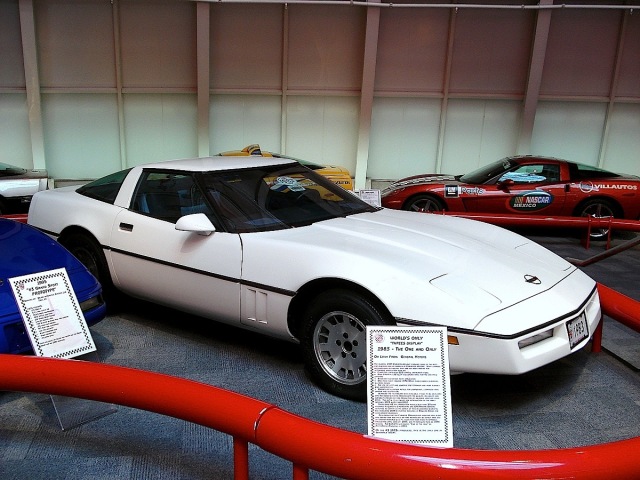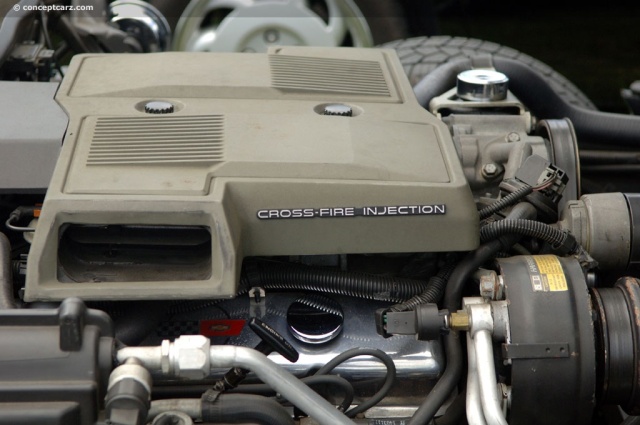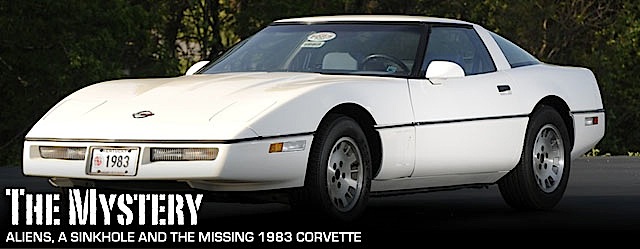 The 1983 Corvette is like the 13th floor of a skyscraper – it doesn’t exist – only simple superstition has nothing to do with the missing year in the Corvette lineup.
The 1983 Corvette is like the 13th floor of a skyscraper – it doesn’t exist – only simple superstition has nothing to do with the missing year in the Corvette lineup.
Anxiety meters were pegging at GM in 1983 because this would have been the car’s 30th anniversary and they clearly needed a winner. The overall American sports car market was floundering under new emissions-regulated pressure. Combine this with a lack of design inspiration and the noble Corvette, after a decade of steady emasculation by Chevrolet, had been in decline since 1973.
To the glass-is-half-empty crowd it appeared as though the age of muscle car nirvana was over. Sadly, it seemed as though it would end unremarkably, not with a bang, but with a whimper, being that the ’82 Corvette with its notoriously wretched Crossfire Injection engine which produced Prius-esque horsepower, came very close to representing the preverbal nail in the brands coffin.
The 1983 Corvette was supposed to be the grand re-birth of the iconic brand, complete with state-of-the-art technology and an engine corralling a herd of horsepower deemed to actually produce some much needed performance. The highly anticipated introduction of the new generation of Corvettes was scheduled for October 1983 and expectations were understandably redlining. However, as any self-respecting Corvette aficionado knows, there was no 1983 Vette. There is no entry listed between 1982 and 1984 in the Corvette Black Book which is the industry standard. So who monumentally screwed the pooch?
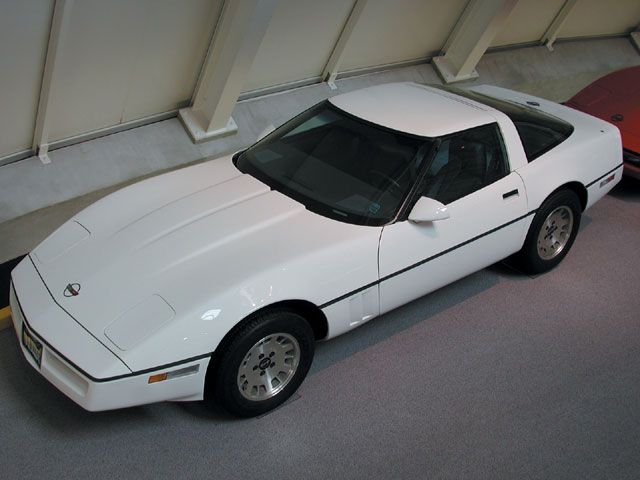
The only existing example of the 1983 Corvette sits in the National Corvette Museum. (Photos courtesy of the National Corvette Museum)
By the Book
This is where things get interesting. The explanations for why no production cars were sold with an ’83 VIN (Vehicle Identification Number) range from predictably corporate, to reasonable and logical, to what the heck? An initial public relations version claimed that GM insisted the new Corvette had to be as perfect as achievable and of the highest possible quality. Based on the fact that the C3 cars retained a chassis identical to the C2 Corvette, GM was determined that the C4 needed to be built new from the tires up.
Production on the ambiguous 1983 had started, but shortly thereafter it was determined that the new design was too complicated and GM simply skipped 1983 altogether. The explanation read that GM attempted to use new technology never before seen on production vehicles, like an LED dashboard, and instead of fiberglass, body panels were made from reaction injected molding plastics.
Yet even with the 30th Anniversary of the Corvette looming large, the design team was unable to have everything ready by the fall 1982 production target. As such, the first new C4 Corvettes were all early 1984 models.
The new Corvette plant in Bowling Green, Kentucky, closed temporarily in October of 1982 and began retooling for the 1984 Corvette. Three months later in January 1983, the news media received their first view of the 1984 Corvette. In March of 1983, the 1984 Corvette officially went on sale in the United States, except for California (they began selling in April). By October of 1983, the plant was in full production. Production of the 1984 Corvette ran for 17 months, marking it as the second highest production run for any Corvette.
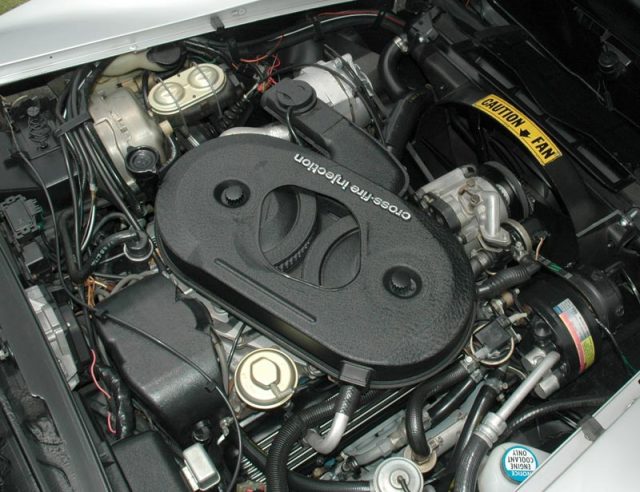
The 1982 Corvette engine bay did offer a glimpse into the future, that’s when a new fuel delivery system called “Cross-Fire Injection” made its debut. (web-cars.com)
More Questions than Answers
The question that begs to be asked then is how many 1983 Corvettes were produced before they ordered a shutdown? Depending on which Corvette source you ask that number varies from 43 to 47, the Corvette Museum however uses the number 43, which also reflects the majority opinion.
GM sources also agree that of the 43 1983 Corvettes produced, 33 were sent to the GM proving grounds for testing, including crash testing, and 10 were left at the factory to evaluate the assembly process at the plant. In the final tally, 42 of these cars were either crashed or crushed.
Even so, a handful of canny, forward looking individuals who recognized the need to retain one 1983 Corvette for posterity, essentially hid one vehicle, changing the paint scheme, and moving it around until they received a commitment from GM that it wouldn’t be destroyed. The one remaining car, number 23, was donated to the National Corvette Museum, where it remains on display and is still owned by General Motors.
The sign on the museum exhibit explains further: “The planned 1983 Corvette brought forward some of the most far reaching design changes in Corvette’s history. Many changes included high-technology that had not been proven for automobile application. Although the technology was available, it had to be developed into the manufacturing process with the quality, reliability, and durability required before production of saleable vehicles could begin.”
The sign continues, “The initial plan called for introduction of the newly designed 1983 in October 1982. There were 43 pre-production models built (but) a decision was made to withhold production (for sale) until January 1983 and to serialize them as 1984 models. The Corvette was named ‘Car of the Year’ by Motor Trend Magazine in 1984.”
The delinquent year in Corvette’s otherwise illustrious and unbroken lineup, and the notion that highly advanced, unproven technology and production delays were the reason for scrapping the 30th Anniversary of Corvette, didn’t fit well with everyone though. In fact, it helped to fuel one particularly colorful and provocatively detailed conspiracy theory, by a source know only as Deepthroat (DT).
DT ignited the Corvette blogosphere with some remarkably detailed and thought provoking conjecture that still echoes today, if only as a source of conversation and enjoyment. What follows is a paraphrased version of DT’s rant.
Deepthroat Speaks
“For decades we have been told the lie that quality and production problems had delayed introduction of the new C4 generation so 1983 was passed over. Or, perhaps you’ve heard the version of the story which includes the twist blaming California’s strict new emissions laws. Let me be the first to tell you this is the greatest bald-faced lie ever told. I am prepared to back up my statements with photographic proof if called upon to do so. But please know that I disclose this information at the risk of my own peril and the personal safety of my family members.”
He continues, “Others who have passed this information to me have mysteriously disappeared and can no longer be called upon for collaboration. But for the greater good of Corvette enthusiasts and humanity at large, I am humbly prepared to pay even with my life so that you may finally know the truth about the 1983 C4 Corvette.”
“It was late in the fall of 1974, in the GM office of engineer David McLellan,” continues DT. “McLellan had an old Harley Earl clay concept Model of the 1954 GM Firebird. He kept it on the shelf as a book-end collecting dust, but on this particular day it was disheveled, fell to the floor, and broke into a million pieces. It seemed like a tragic loss of history, but as McLellan stooped to pick up the pieces, he realized that there was a document inside, tucked away in one of Harley Earl’s last and most imaginative designs.”
“What he deciphered from the manuscript he determined was knowledge, not of this world and not of our time – it was Harley Earl’s vision for a new Corvette, the C4.” Earl was the initial designated head of Design at GM According to DT, the Cold War and our relationship with Russia ultimately hinged on the unholy advanced C4 technology discovered by McLellan.
There were hundreds of 1983 cars produced and operations were running incredibly smooth, claims DT. That is until – “The day the unnamed government agency stormed the plant in Bowling Green. Simultaneously, a team in business suits took over several floors of the GM Building in Detroit. Top GM executives were escorted to the airport where jets with turbine fans spinning, waited to make the quick trip from the seclusion of Bowling Green.”
“Once the audience was captive,” continues DT, “government officials described their great concerns about the 1983 C4 Corvette and its fantastic leap in technological advance. With tacit and cryptic threat they stated their intention to discover the true source of this new knowledge.”
“But what needed to be accomplished on that day was every single 1983 C4 on the line, on the lot, everywhere, every car, had to be destroyed, never to been seen again.
All were destroyed except for the one Ronald Reagan was quite fond of, which he kept at Camp David. It remained there at Camp David until Barack Obama had it destroyed and symbolically replaced it with a Toyota FT-EV II. The car in the Museum and the story behind it of course is fraudulent.”
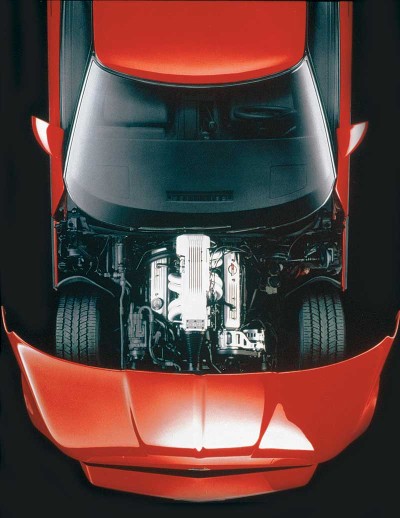 DT then makes the connection between Reagan’s unveiling of an incredible new defensive system called the Strategic Defense Initiative (STI), which Reagan’s detractors renamed Star Wars. “Any idiot could see this was an offensive threat as well,” declares DT. “The threat of this system broke the back of the Soviet Union which led to the end of the Cold War.”
DT then makes the connection between Reagan’s unveiling of an incredible new defensive system called the Strategic Defense Initiative (STI), which Reagan’s detractors renamed Star Wars. “Any idiot could see this was an offensive threat as well,” declares DT. “The threat of this system broke the back of the Soviet Union which led to the end of the Cold War.”
“Critics mocked the whole idea calling it impossible based upon their presumption we did not have the technology to build it. But on this point I assert the technology came out of Bowling Green, through the hands of David McLellan, from the pen of Harley Earl, and out of the mind of?”
DT even details an explanation for how a secret of this magnitude could be kept quiet for all these years. “Government officials offered fantastic and lucrative incentives”, he claims, “which were easily revocable, at the same time promising continued IRS involvement into their personal and corporate financial affairs from now until Kingdom comes.”
In his Own Words – Dave McLellan
The second Corvette Chief Engineer at Chevrolet (from 1975-1992), Dave McLellan, wrote a book chronicling his tenure at GM titled, “Corvette from the Inside.” In the book McLellan gives his own succinct, all but disinterested, account of what happened in ’83.
McLellan explains, “Because of delays with the introduction of the new generation (C4) Corvette, production started in the early part of 1983. The new car could be called a 1984 model. The federal government defines the model year by its emission certification rules, which state that the model year can contain only one January 1. There were a lot of spirited discussions at Chevrolet about the uninterrupted Corvette tradition, but in the end, Chevrolet opted for the logic of building for 17 months and the reduction in paperwork of not having to rectify for the 1984 model year.”
The Sinister Sinkhole at NCM
Proving that fact is every bit as gripping as fiction, earlier this year, on Wednesday, February 13th, 2014 a car-nivorous sinkhole opened wide under the National Corvette Museum swallowing eight cars. At 5:44 a.m. motion detectors were set off and the local police were alerted. “Security cameras at the museum caught the destruction,” explained Executive Director Wendell Strode. “When emergency personnel got to the museum, they discovered a sinkhole 40 ft wide and 25 to 30 ft deep.” It’s pretty significant,” he added.
Of the eight cars consumed by the sinkhole, which occurred inside the museum’s iconic spire called the Sky Dome, the museum owned six, and General Motors owned two. GM’s Bowling Green Corvette plant, the only factory building Corvettes, is located across a highway, less than a half-mile from the museum.
Bowling Green is located about 60 miles northeast of Nashville and 100 miles southwest of Louisville, and sits at the edge of a karst region, therefore sinkholes are not an uncommon occurrence.
Engineers determined that the building did not sustain any structural damage since the sinkhole was in the middle of the Sky Dome, and at this point, no other potential sinkholes appear to be threatening the rest of the museum. Museum spokesman Bob Bubnis said officials anticipate repairing the sinkhole damage but said no timetable or plans for the repairs have been set. Officials don’t anticipate having to move to a new site.
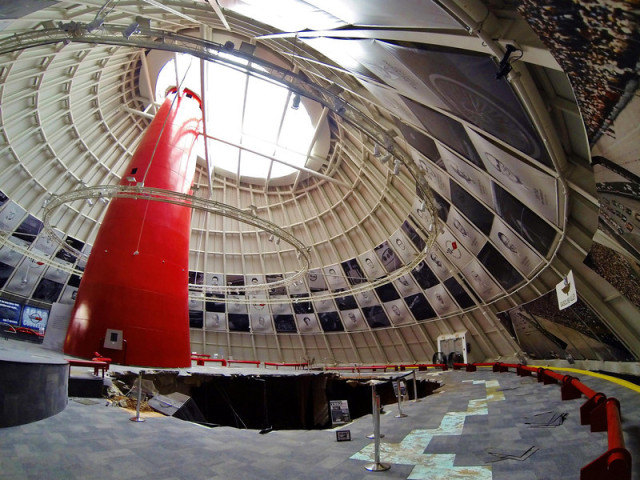 Under the Sky Dome’s familiar red spire and towering vaulted 100-foot ceilings sits the circular chamber that cradled the rare vehicles. The room feels like a cathedral and for the ardent, it represents the Church of the Corvette. Its hallowed ground is home to more than 70 exclusive Corvettes, including several prototypes and of course number 23.
Under the Sky Dome’s familiar red spire and towering vaulted 100-foot ceilings sits the circular chamber that cradled the rare vehicles. The room feels like a cathedral and for the ardent, it represents the Church of the Corvette. Its hallowed ground is home to more than 70 exclusive Corvettes, including several prototypes and of course number 23.
On the day of the sinkhole incident, staff personnel were able to move 20 cars out of the Sky Dome, and later, only after engineers determined that nothing was in danger of collapsing, the staff was allowed to remove only one other car – the one surviving example of the “1983” Corvette – the automotive gods had once more spared it from the abyss.



